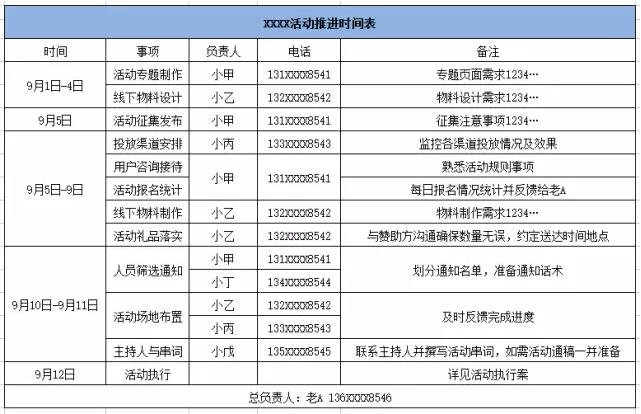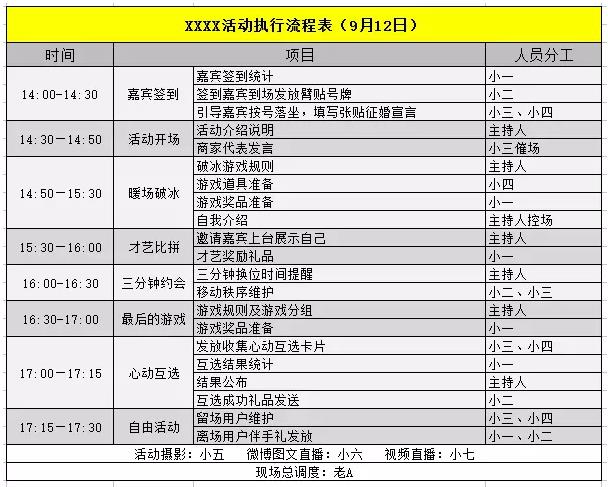Activity Operation Plan and execute the whole process list of an offline activity.

Activities are planned events with a purpose, such as attracting new users, brand exposure, giving back to users, improving user activity, etc., according to the existing operation rhythm or unexpected situations. Activities generally carry prizes or benefits, and often call some internal or external resources for promotion.
For the operation of the event, you need to be clear about two points: why and how.
Why do you do activities?
We have already said in "Don’t worry about making a plan for the activity operation, give me a reason to do the activity first". You should know what your purpose is and what your reason is.
So how to do the activities?
Activities are divided into online activities and offline activities.
For the specific operation process of online activities, please refer to "How to plan an online activity? There are five steps".
The online activities of the online part and the previous section basically overlap in general. Here, let’s briefly explain some precautions. The focus will be on offline execution. After all, many companies don’t have dedicated executives to do the execution work for every offline activity. In many cases, they still have to rely on the activity operation to coordinate the execution.
Also according to the previous routine, from the beginning.
Offline activities generally involve sales or BD, sponsorship, venues and so on, which need to be determined in advance. If there is no sales or BD department involved, unfortunately, these sales or BD tasks may be your job. Er … Because I don’t know much about how to be a qualified BD. So, let’s assume that someone will do the work.
What about after the sponsorship? You will become Party B in the operation of the activity, and all aspects such as the theme and rules of the activity may be bound by Party A. What you need to do is to be psychologically prepared for being abused by Party A, and all aspects of the activity must be communicated with Party A for confirmation. As the saying goes, the plan has been changed thousands of times, and it is still like the first love for Party A. Anyway, the final plan is still like this:
- activity themeThink it over in advance and negotiate with Party A. Anyway, it’s ultimately up to Party A’s uncle.
- activity time: Make a reservation in advance, negotiate with Party A, and consider whether the user’s time is convenient.
- site of activity: Listen to Party A’s uncle
- Active object: Your existing users or potential users are also potential users of Party A (this is one of the foundations of cooperation).
- Activity descriptionShow what you will do, what activities you will do and what highlights you have, so as to impress Party A to provide sponsorship.
- Promotion channel: launch time, launch channel, launch resource location, etc.
- anticipated/desired/intended effect: Prepare two parts, one is for Party A to see, and write clearly what benefits the activity can bring to Party A; One is internal, such as how the activity helps the platform data or users, and there must be a rough data.
- cost estimation: If there is Party A, you need to give Party A a quotation, including the expenses of various promotion channels, offline execution fees, and gifts or prizes in each link.
At this point, your plan has been approved by Party A or signed a cooperation contract, and it has officially entered the implementation stage. Generally, it is necessary to convene a preparatory meeting for the participants in this activity. Push forward according to the determined activity time, sort out the activity nodes, assign all the preparatory work and determine the person in charge of each work, and the general person in charge of the activity will track the completion at any time.

Whether it is a small activity or a big activity, the preparation period of an activity will generally include all the items in the above table. The arrangement of time nodes and the number of participants depend on the actual situation of their respective companies.
The following is a brief breakdown of some important considerations:
1. Activity page making
It is necessary to prepare a requirement document, list the process and requirements clearly, explain how to design and how to realize the key issues such as when to go online, and then keep in touch with the technology at any time to ensure that the page is completed on time and passed the test without problems before it is officially launched.
2. Material design and production
Also explain the design requirements, including styles, patterns, sizes, etc., and follow up the production situation of the production company, including the use of materials, color deviation, etc., to ensure the completion of quality and quantity.
3. Matters needing attention in activity collection
- Activity description: At this time of XX, we will join hands with XXX (the uncle of Party A) to do something, what’s fun and interesting, what benefits or prizes we can get from participating, and so on.
- activity theme: It was agreed with Party A.
- activity time: It was negotiated with Party A.
- site of activityWrite down the detailed location. If it is difficult to find it, remember to indicate the route.
- Active object: your existing users or potential users
- Participation mode: At least the registered user should leave his name and contact information in order to inform him that the registration is successful, and the rest depends on the needs of the activity.
- Activity ruleVarious requirements and precautions should be clearly stated in advance, such as the screening criteria for participants (gender, age, height, occupation, etc.), dress requirements, the deadline for registration, the notification time for successful registration, and the consultation methods for activities. If it is a charging activity, the payment method and account number should be clearly written, and what conditions can be refunded and how to refund it. Be sure to leave the activity question consultation method. No matter how simple and clear your rules are, there will always be some users who have all kinds of unexpected questions, especially the charging activities. Remember!
- Venue and prize display: put pictures or videos
4. Registration Statistics and Notice
The registration situation must be counted in time. Once it is found that the number of applicants is too small and the gap from the expected number is too large, it will be fed back to the general manager in time to discuss whether to increase the delivery channels and efforts to ensure the number of activities. Inform the successful users before the event, and confirm the specific number of people who can attend the event on time according to the contact information left by the registration, such as phone number or text message.
5. Keep the docking with Party A by special personnel., keep abreast of changes in Party A’s demand, and notify the general manager to make corresponding adjustments.
6. Determine the event host in advance, so that the other party can arrange time and be familiar with the activities.
7. The most important point:Participants keep in touch at any time to share information. It is best to build an activity group, so that everyone can inform each other of their work progress and changes in activity arrangement in time, so as to avoid mistakes in one link and ultimately affect the overall preparation work.
In the process of all preparations being carried out in an orderly way, the person in charge of the activity also has to make an on-site execution plan of the activity, and in combination with the set activity flow, assign all the work in the on-site execution such as sign-in, hosting, photography, props, field affairs, live broadcast, etc. to specific individuals, and the execution plan is generally accurate to minutes. One or two days before the off-line execution, call all the executives to hold a mobilization meeting, distribute the execution plan, and break down the tasks one by one to ensure that everyone knows what they should do when they arrive at the site.
The on-site implementation plan of the activity includes:
- Activity purpose: briefly describe the activity and explain the purpose of this activity. (The executives and project promoters are not necessarily a group of people, so they need to be declared again. )
- Time and place of activityGenerally, the staff should arrive 1-2 hours before the official start time of the activity, get familiar with the venue environment, and prepare their own materials and prizes, especially the students who are responsible for signing in. They should arrive in advance to gather the users of the activity, so as not to make users feel that they are not received early. It is also convenient to gather users, and then go to the user to find the sign-in person in charge to prepare for the sign-in activities.
- Activity flowThe activity flow chart depends on the arrangement of activity links, and each job is assigned to individuals from the beginning to the end. The process of large-scale activities is complex, involving many resources and many people, and it needs to be meticulous. However, there are usually special executives to help make them, which may not be used by many people. So let’s take a small event of 50 people dating as an example. Everyone is familiar with the basic routines and can add or delete them according to their own activities.

Generally, the activity link design has been basically formed when the activity plan is determined. What you need to do here is to clarify the rules of each link. It should be noted that the activity operation should focus on the user experience when designing the activity link, and design the activity content suitable for the target users. It is definitely inappropriate for you to let a group of elderly people ride a roller coaster and let a group of single men and women kiss when they get up, which seriously violates the user experience. The brand shouldn’t have died, but it died when it was done.
- List of materials and gifts: Indicate the types and quantities of all materials and gifts needed for the activity item by item, and note which link and where each item appears during the activity execution. Then hand it over to their respective responsible persons. If there are many kinds of materials and gifts needed, it is best to make another form and give it to the responsible persons of various items.
- Activity emergency planOffline activities reflect the brand and service quality of a platform, and they are in direct contact with users. You never know how many unexpected situations will be waiting for you to solve. Once they are not handled well, they may directly lose users and affect the brand image. You can’t exaggerate how many kinds of plans you make for the operation of the activity. At least, you should imagine several most likely problems before the activity starts, and think of corresponding solutions, notify the corresponding person in charge of the possible problems at the mobilization meeting, and start the emergency plan quickly once problems are found during the activity.
On-site execution is to implement the activity flow table of the previous step one by one. Of course, the best state is that the executives perform their duties, the users are satisfied and the activities go smoothly. However, we are afraid of everything, but most of the time, perfect activities are just extravagant hopes. The general manager should be calm, respond quickly to various situations, make countermeasures, and notify the corresponding person in charge.
Common problems and solutions in field execution are as follows:
The executives should quickly enter their respective posts after arriving at the scene, sign in to guide the maintenance users and the host to familiarize themselves with the string words again, and prepare to send them to the scheduled location in advance, and communicate with the photographers in advance to explain what scenes and close-ups are needed. If there are multiple photographers, they should do a good job of division of responsibilities … In short, all the site preparations should be done as soon as possible. Build an activity execution group in advance, and notify in time if there is an emergency. For example, if an executive is late, the general manager should immediately arrange for others to make up for it; If someone forgets the work content or is absent-minded, the colleagues next to him should promptly remind him to help. In short, the executive should make Qi Xin work together to ensure the smooth progress of the activity.
In the user sign-in session, the person in charge of sign-in should quickly contact the users who are not present on time to inquire about the situation and mark it clearly, so as to make an accurate estimate of the final number of people present. Once the number of users is insufficient, inform the general manager in time to evaluate whether it will affect the follow-up activities. If it does, the general manager will find the moderator to inform the adjustment plan as soon as possible after making a decision, and notify the executives of the affected links; If there are problems or conflicts among participating users, if the corresponding person in charge can’t solve them alone, inform the general person in charge of the activity site to coordinate and solve them at the first time.
If the process changes again during the activity, the general manager will quickly inform the host during the intermission so that the host can respond on the spot and inform other executives.
After all the scheduled processes are finished, the users leave, so all the executives can relax. Let’s take a photo, take stock of the remaining materials and gifts, and complete the task of clearing the field, so that we can have a celebration dinner to treat ourselves with peace of mind.
After the event, there is usually a review of the event, and when to release it is agreed with Party A in advance. If it is urgent to publish even after the event, the general manager should set up the event reviewer in advance, write synchronously during the event, and copy the photos in time, so that the manuscript can be published soon after the event. After the manuscript is published, it is quickly handed over to the colleague in charge of the delivery channel to arrange delivery. If the activity review is not urgent, it can be done another day, just send it before the appointed time.
After the activity, it is generally necessary to submit an activity closing report to Party A, which generally includes an overview of the activity, statistics of the activity effect and other results and data to make a case, so that this cooperation will come to an end. Whose customer will write the closing of the activity, if it is sales talk, then sales will do it. If it’s a customer you brought in by the event operation, congratulations on writing this case.
Whether it is necessary to write the closing of the event yourself or not, you should make a report on the effect of the event in time after the event, and sum up the experience and lessons in addition to the achievements in the closing. You need to comb the whole activity from beginning to end, focusing on two aspects:
- Activity process, which links have poor connection and which links have problems, and think about how to optimize the process in the future;
- Summarize all the problems and your own countermeasures, which are good and which are insufficient, and how to improve them in the future. It is best to record them.
Through this resumption, you can clearly understand what is successful and what is unsuccessful in an activity, keep the successful part, and remind yourself of the failed part to pay attention next time and try to solve it.
There are always all kinds of unexpected problems in activities. Activity operation should grow through activities again and again. After each activity, sum up your successes and failures carefully. Don’t fall in the same pit twice, and constantly accumulate experience. Your activity operation system will become more and more perfect with your experience accumulation, which will enable you to avoid most of the deep pits of activity operation. Eventually, there will be fewer problems in your activities and the user experience will be better and better.
Don’t worry about making a plan. Give me a reason to do the activity first.
There are five steps to how to plan an online activity.
Author: Always changing vests, WeChat: Hard to operate
This article was originally published by @ Always changing vest. Everyone is a product manager. Reprinting is prohibited without permission.